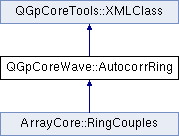
Brief description of class still missing. More...
#include <AutocorrRing.h>

Public Member Functions | |
| AutocorrRing () | |
| AutocorrRing (const AutocorrRing &o) | |
| AutocorrRing (double rMin, double rMax) | |
| double | maxRadius () const |
| double | minRadius () const |
| bool | operator< (const AutocorrRing &o) const |
| AutocorrRing & | operator= (const AutocorrRing &o) |
| bool | operator== (const AutocorrRing &o) const |
| void | setRadii (double rMin, double rMax) |
| virtual const QString & | xml_tagName () const |
Static Public Attributes | |
| static const QString | xmlAutocorrRingTag = "AutocorrRing" |
Protected Member Functions | |
| virtual XMLMember | xml_member (XML_MEMBER_ARGS) |
| virtual bool | xml_setProperty (XML_SETPROPERTY_ARGS) |
| virtual void | xml_writeProperties (XML_WRITEPROPERTIES_ARGS) const |
Brief description of class still missing.
Full description of class still missing
| QGpCoreWave::AutocorrRing::AutocorrRing | ( | ) | [inline] |
Default constructor (init zero rings)
: XMLClass() { _minRadius=1.0; _maxRadius=2.0; }
| QGpCoreWave::AutocorrRing::AutocorrRing | ( | const AutocorrRing & | o | ) | [inline] |
References maxRadius(), minRadius(), and setRadii().
| QGpCoreWave::AutocorrRing::AutocorrRing | ( | double | rMin, |
| double | rMax | ||
| ) | [inline] |
Init a ring with minium (rMin) and maximum (rMax) radii
References setRadii().
| double QGpCoreWave::AutocorrRing::maxRadius | ( | ) | const [inline] |
Referenced by AutocorrRing(), SpacSelector::createObjects(), main(), SpacSelector::radiusScroll_valueChanged(), SPACLoopTask::run(), ArrayCore::RingCouples::setCouples(), QGpCoreWave::AutocorrEngine::setHorizontalRing(), RingBrowser::setRing(), DinverDCGui::AutocorrViewer::setTarget(), and QGpCoreWave::AutocorrEngine::setVerticalRing().
{return _maxRadius;}
| double QGpCoreWave::AutocorrRing::minRadius | ( | ) | const [inline] |
Referenced by AutocorrRing(), SpacSelector::createObjects(), main(), SpacSelector::radiusScroll_valueChanged(), SPACLoopTask::run(), ArrayCore::RingCouples::setCouples(), QGpCoreWave::AutocorrEngine::setHorizontalRing(), RingBrowser::setRing(), DinverDCGui::AutocorrViewer::setTarget(), and QGpCoreWave::AutocorrEngine::setVerticalRing().
{return _minRadius;}
| bool QGpCoreWave::AutocorrRing::operator< | ( | const AutocorrRing & | o | ) | const [inline] |
| AutocorrRing & QGpCoreWave::AutocorrRing::operator= | ( | const AutocorrRing & | o | ) | [inline] |
| bool QGpCoreWave::AutocorrRing::operator== | ( | const AutocorrRing & | o | ) | const [inline] |
| void QGpCoreWave::AutocorrRing::setRadii | ( | double | rMin, |
| double | rMax | ||
| ) | [inline] |
Referenced by AutocorrRing().
{
if(rMin < rMax) {
_minRadius=rMin;
_maxRadius=rMax;
} else {
_maxRadius=rMin;
_minRadius=rMax;
}
}
| XMLMember QGpCoreWave::AutocorrRing::xml_member | ( | XML_MEMBER_ARGS | ) | [protected, virtual] |
Re-implement this function to offer XML restore (children and properties) support to your class.
From tag and map (with contains the attibute value) return a unique identifier under the format of a XMLMember. XMLMember is initialized with 3 types of contructors:
Map of attributes can be inspected in this way (can be achived also in xml_setProperty()):
static const QString tmp("childrenName"); XMLRestoreAttributeIterator it=map.find(tmp); if(it!=map.end()) { // found attribute "childrenName" }
If the map of attributes is not used:
Q_UNUSED(attributes);
if(tag=="x1") return XMLMember(0);
else if(tag=="y1") return XMLMember(1);
else if(tag=="x2") return XMLMember(2);
else if(tag=="y2") return XMLMember(3);
else return XMLMember(XMLMember::Unknown);
Arithmetic operations + and - apply to XMLMember to avoid confusion of property id numbers between inherited objects. Offset 3 corresponds to the number of properties defined in this object.
if(tag=="anInteger") return XMLMember(0); else if(tag=="aString") return XMLMember(1); else if(tag=="aDouble") return XMLMember(2); return AbstractLine::xml_member(tag, attributes, context)+3;
For the arguments of this function use Macro XML_MEMBER_ARGS.
Reimplemented from QGpCoreTools::XMLClass.
References TRACE.
| bool QGpCoreWave::AutocorrRing::xml_setProperty | ( | XML_SETPROPERTY_ARGS | ) | [protected, virtual] |
Re-implement this function to offer XML restore properties support to your class.
From memberID set the corresponding property with value content. The map of attributes is given as a supplementary information (not useful in all cases).
For a general case:
Q_UNUSED(attributes); double val=content.toDouble(); switch (memberID) { case 0: _x1=val; return true; case 1: _y1=val; return true; case 2: _x2=val; return true; case 3: _y2=val; return true; default: return false; }
For classes inheriting other classes (see also xml_member())
switch (memberID) { case 0: _anInteger=content.toString(); return true; case 1: _aString=content.toInt(); return true; case 2: _aDouble=content.toDouble(); return true; default: return AbstractLine::xml_setProperty(memberID-3, map, content);
For the arguments of this function use Macro XML_SETPROPERTY_ARGS.
Reimplemented from QGpCoreTools::XMLClass.
References TRACE.
{
TRACE;
Q_UNUSED(tag);
Q_UNUSED(attributes)
Q_UNUSED(context);
switch (memberID) {
case 0: _minRadius=content.toDouble(); return true;
case 1: _maxRadius=content.toDouble(); return true;
default: return false;
}
}
| virtual const QString& QGpCoreWave::AutocorrRing::xml_tagName | ( | ) | const [inline, virtual] |
Implements QGpCoreTools::XMLClass.
{return xmlAutocorrRingTag;}
| void QGpCoreWave::AutocorrRing::xml_writeProperties | ( | XML_WRITEPROPERTIES_ARGS | ) | const [protected, virtual] |
Reimplemented from QGpCoreTools::XMLClass.
References TRACE, and QGpCoreTools::XMLClass::writeProperty().
{
TRACE;
Q_UNUSED(context);
writeProperty(s, "minRadius", _minRadius);
writeProperty(s, "maxRadius", _maxRadius);
}
const QString QGpCoreWave::AutocorrRing::xmlAutocorrRingTag = "AutocorrRing" [static] |